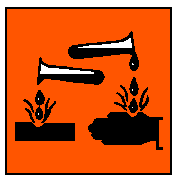International Chemical Safety Cards
| POTASSIUM HYDROXIDE | ICSC: 0357 |
| POTASSIUM HYDROXIDE Caustic potash Potassium hydrate Potassium lye KOH Molecular mass: 56.1 CAS # 1310-58-3 RTECS # TT2100000 ICSC # 0357 UN # 1813 EC # 019-002-00-8 |
 |
| TYPES OF HAZARD/ EXPOSURE |
ACUTE HAZARDS/ SYMPTOMS |
PREVENTION | FIRST AID/ FIRE FIGHTING |
| FIRE | Not combustible. Contact
with moisture or water may generate sufficient heat to ignite combustible materials. |
|
In case of fire in the
surroundings: all extinguishing agents allowed. |
| EXPLOSION | |
|
|
| EXPOSURE | |
PREVENT DISPERSION OF DUST!
AVOID ALL CONTACT! |
IN ALL CASES CONSULT A
DOCTOR! |
| INHALATION | Corrosive. Burning
sensation. Cough. Laboured breathing. |
Local exhaust or breathing
protection. |
Fresh air, rest.
Half-upright position. Artificial respiration if indicated. Refer for medical attention. |
| SKIN | Corrosive. Redness.
Serious skin burns. Pain. |
Protective gloves.
Protective clothing. |
Remove contaminated
clothes. Rinse skin with plenty of water or shower. Refer for medical attention. |
| EYES | Corrosive. Redness. Pain.
Blurred vision. Severe deep burns. |
Face shield or eye
protection in combination with breathing protection if powder. |
First rinse with plenty of
water for several minutes (remove contact lenses if easily possible), then take to a
doctor. |
| INGESTION | Corrosive. Abdominal pain.
Burning sensation. Collapse. |
Do not eat, drink, or smoke
during work. |
Rinse mouth. Do NOT induce
vomiting. Give plenty of water to drink. Refer for medical attention. |
| SPILLAGE DISPOSAL | STORAGE | PACKAGING & LABELLING | ||
| Sweep spilled substance into
suitable containers. Wash away remainder with plenty of water (extra personal protection:
complete protective clothing including self-contained breathing apparatus). |
Separated from strong acids,
metals, food and feedstuffs, and combustible materials. Dry. Well closed (see Notes). |
Do not transport with food
and feedstuffs. C symbol R: 35 S: 2-26-37/39 UN Hazard Class: 8 UN Packing Group: II |
||
| SEE IMPORTANT INFORMATION ON BACK | ||||
|
||||